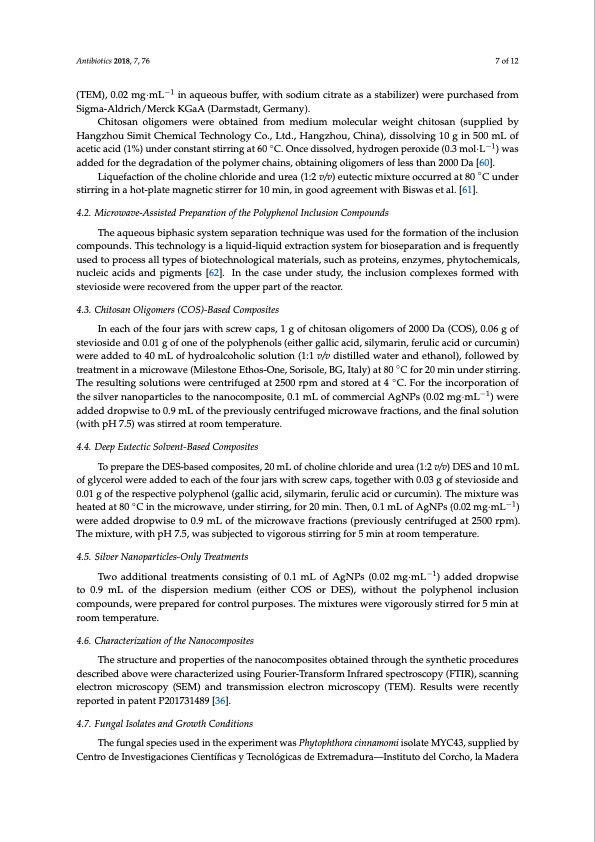
PDF Publication Title:
Text from PDF Page: 007
Antibiotics 2018, 7, 76 7 of 12 (TEM), 0.02 mg·mL−1 in aqueous buffer, with sodium citrate as a stabilizer) were purchased from Sigma-Aldrich/Merck KGaA (Darmstadt, Germany). Chitosan oligomers were obtained from medium molecular weight chitosan (supplied by Hangzhou Simit Chemical Technology Co., Ltd., Hangzhou, China), dissolving 10 g in 500 mL of acetic acid (1%) under constant stirring at 60 ◦C. Once dissolved, hydrogen peroxide (0.3 mol·L−1) was added for the degradation of the polymer chains, obtaining oligomers of less than 2000 Da [60]. Liquefaction of the choline chloride and urea (1:2 v/v) eutectic mixture occurred at 80 ◦C under stirring in a hot-plate magnetic stirrer for 10 min, in good agreement with Biswas et al. [61]. 4.2. Microwave-Assisted Preparation of the Polyphenol Inclusion Compounds The aqueous biphasic system separation technique was used for the formation of the inclusion compounds. This technology is a liquid-liquid extraction system for bioseparation and is frequently used to process all types of biotechnological materials, such as proteins, enzymes, phytochemicals, nucleic acids and pigments [62]. In the case under study, the inclusion complexes formed with stevioside were recovered from the upper part of the reactor. 4.3. Chitosan Oligomers (COS)-Based Composites In each of the four jars with screw caps, 1 g of chitosan oligomers of 2000 Da (COS), 0.06 g of stevioside and 0.01 g of one of the polyphenols (either gallic acid, silymarin, ferulic acid or curcumin) were added to 40 mL of hydroalcoholic solution (1:1 v/v distilled water and ethanol), followed by treatment in a microwave (Milestone Ethos-One, Sorisole, BG, Italy) at 80 ◦C for 20 min under stirring. The resulting solutions were centrifuged at 2500 rpm and stored at 4 ◦C. For the incorporation of the silver nanoparticles to the nanocomposite, 0.1 mL of commercial AgNPs (0.02 mg·mL−1) were added dropwise to 0.9 mL of the previously centrifuged microwave fractions, and the final solution (with pH 7.5) was stirred at room temperature. 4.4. Deep Eutectic Solvent-Based Composites To prepare the DES-based composites, 20 mL of choline chloride and urea (1:2 v/v) DES and 10 mL of glycerol were added to each of the four jars with screw caps, together with 0.03 g of stevioside and 0.01 g of the respective polyphenol (gallic acid, silymarin, ferulic acid or curcumin). The mixture was heated at 80 ◦C in the microwave, under stirring, for 20 min. Then, 0.1 mL of AgNPs (0.02 mg·mL−1) were added dropwise to 0.9 mL of the microwave fractions (previously centrifuged at 2500 rpm). The mixture, with pH 7.5, was subjected to vigorous stirring for 5 min at room temperature. 4.5. Silver Nanoparticles-Only Treatments Two additional treatments consisting of 0.1 mL of AgNPs (0.02 mg·mL−1) added dropwise to 0.9 mL of the dispersion medium (either COS or DES), without the polyphenol inclusion compounds, were prepared for control purposes. The mixtures were vigorously stirred for 5 min at room temperature. 4.6. Characterization of the Nanocomposites The structure and properties of the nanocomposites obtained through the synthetic procedures described above were characterized using Fourier-Transform Infrared spectroscopy (FTIR), scanning electron microscopy (SEM) and transmission electron microscopy (TEM). Results were recently reported in patent P201731489 [36]. 4.7. Fungal Isolates and Growth Conditions The fungal species used in the experiment was Phytophthora cinnamomi isolate MYC43, supplied by Centro de Investigaciones Científicas y Tecnológicas de Extremadura—Instituto del Corcho, la MaderaPDF Image | Silver Nano Polyphenol Inclusion Compounds Composites

PDF Search Title:
Silver Nano Polyphenol Inclusion Compounds CompositesOriginal File Name Searched:
Silver_Nanoparticles_and_Polyphenol_Inclusion_Comp.pdfDIY PDF Search: Google It | Yahoo | Bing
Turbine and System Plans CAD CAM: Special for this month, any plans are $10,000 for complete Cad/Cam blueprints. License is for one build. Try before you buy a production license. More Info
Waste Heat Power Technology: Organic Rankine Cycle uses waste heat to make electricity, shaft horsepower and cooling. More Info
All Turbine and System Products: Infinity Turbine ORD systems, turbine generator sets, build plans and more to use your waste heat from 30C to 100C. More Info
CO2 Phase Change Demonstrator: CO2 goes supercritical at 30 C. This is a experimental platform which you can use to demonstrate phase change with low heat. Includes integration area for small CO2 turbine, static generator, and more. This can also be used for a GTL Gas to Liquids experimental platform. More Info
Introducing the Infinity Turbine Products Infinity Turbine develops and builds systems for making power from waste heat. It also is working on innovative strategies for storing, making, and deploying energy. More Info
Need Strategy? Use our Consulting and analyst services Infinity Turbine LLC is pleased to announce its consulting and analyst services. We have worked in the renewable energy industry as a researcher, developing sales and markets, along with may inventions and innovations. More Info
Made in USA with Global Energy Millennial Web Engine These pages were made with the Global Energy Web PDF Engine using Filemaker (Claris) software.
Infinity Turbine Developing Spinning Disc Reactor SDR or Spinning Disc Reactors reduce processing time for liquid production of Silver Nanoparticles.
| CONTACT TEL: 608-238-6001 Email: greg@infinityturbine.com | RSS | AMP |